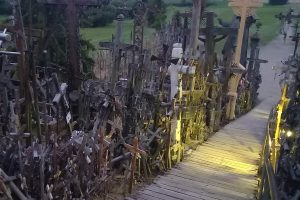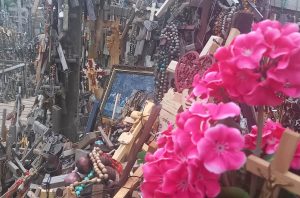Memorials tagged with flowers
Despite the fact that people caught attempting to remove crosses from the site faced harsh punishments, locals still continued to place crosses here during the 1960s and ’70s. Nowadays it is forbidden to remove a cross from the site, but any visitor is welcome to plant a new one (up to a certain size). Devotees can buy simple wooden crucifixes from enterprising vendors near the visitor centre; these vendors also loan marker pens so that the devotees can write a family name, prayer or wish onto the cross before placing it in the soil.
Large and tiny, expensive and cheap, wood and metal, the crosses are devotional, to accompany prayers or finely carved folk-art masterpieces. Others are memorials tagged with flowers, a photograph, or other mementos of the deceased, and inscribed with a sweet or sacred message. Traditional Lithuanian koplytstulpis (wooden sculptures of a figure topped with a little roof) intersperse the crosses, as do magnificent sculptures of the Sorrowful Christ (Rūpintojėlis). If you wish to add your own, souvenir traders in the car park sell cross big and small. Some of the crosses are devotional, others are memorials (many for people deported to Siberia). They vary greatly in size and some are accompanied by mournful statues of the Virgin Mary.



